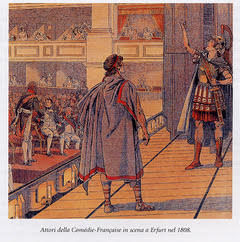Talma in Weimar
DOI:
https://doi.org/10.62336/unibg.eac.33.497Keywords:
Talma, Goethe, Schiller, Humboldt, theatre aestheticsAbstract
Between 1799 and 1809, French actor Talma and German poet Goethe explored art and politics. Talma, from Théâtre-Français, preferred contemporary tragedies prioritizing the observation of nature over adherence to classical models. Meanwhile, in Weimar, Goethe pursued a novel classicism, blending traditional elements with a new sensibility. Goethe in Weimar aimed for a mix of tradition and new vibes. Despite differences, they bonded over a desire for bourgeois sens of tragic. Political changes, like Napoleon's rise, curtailed their freedom, ending the French-German cultural connection.

Downloads
Published
How to Cite
Issue
Section
License
Copyright (c) 2024 Elephant & Castle

This work is licensed under a Creative Commons Attribution 4.0 International License.





